Google FedEx SmartPost or UPS SurePost, and plenty of hits show up in the search results. Some reviews are positive, extoling benefits that include cost effectiveness and fewer surcharges over Air/Ground alternatives, end-to-end package visibility, free Saturday delivery and more.
However, your search results will include complaints ranging from transit times that were too lengthy to crushed/damaged packages.
One thing’s for sure: With the meteoric growth of ecommerce – and consumer demand for free or low cost shipping – these services are here to stay. Residential shippers that continue to ship UPS Ground Residential and/or FedEx Home Delivery are wise to evaluate FedEx SmartPost and UPS SurePost rates and services, in addition to other USPS service partners like Newgistics, OSM Worldwide and DHL Global Mail.
Each offers cost-effective, non-guaranteed means of shipping non-urgent, lightweight (up to 70 pounds), business-to-consumer packages in a partnership with the United States Postal Service. Companies like FedEx, UPS and DHL – often referred to as parcel expeditors, aggregators and/or consolidators – leverage USPS Parcel Select services, a postal discount program that combines the strengths of the parcel expeditor with the vast delivery network of the USPS. The parcel expeditors handle pickup, sortation, transportation and induction to the USPS hub. USPS handles the “final mile” delivery, usually to a residence.
There are three entry, or induction, points within the USPS delivery network: Network Distribution Centers (NDC’s), Sectional Center Facilities (SCF’s), and Destination Delivery Units (DDU’s). The deeper the induction to the USPS, the greater the workshare discounts enjoyed by the consolidator, and in turn, the greater the cost savings available to shippers.
While the majority of FedEx SmartPost packages are entered at the DDU – the final postal facility that delivers to the package recipient – induction points also include NDC’s and SCF’s. On the other hand, UPS SurePost tenders packages to the USPS at the DDU.
While transit times are not guaranteed, delivery is generally achieved within 2-8 days within the contiguous 48 states, although how long it takes is highly variable and determined by unique origin/destination pairings, service provider’s network, induction point and other factors.
Win, Win Win!
Parcel Select service avoids many costs typically associated with air and ground delivery including the Residential Surcharge, which is currently $3.20 (plus fuel surcharges), in addition to many other accessorial charges. Although both SmartPost and SurePost began assessing Delivery Area Surcharges (DAS) in July 2013, the fee is only $.25 – significantly lower than the $2.15-$3.50 DAS charges for air and ground shipments.
Parcel Select services offer advantages to each of the parties involved: the shipper, the parcel expeditor and the USPS. The shipper benefits by keeping shipping costs low in order to offer its customers an economical alternative to Ground residential delivery at a lower price point. The parcel carriers benefit by economies of scale; the more they aggregate, the more “entry” and “saturation” discounts they can earn from the USPS. The hybrid service allows the carriers to lower operating costs by consolidating multiple deliveries to a single point of USPS entry, while avoiding the high costs associated with residential deliveries. Finally, the USPS benefits by receiving additional package volumes and revenues, while incurring marginal cost increases since postal carriers are making mail deliveries to those same mailboxes anyway.
This helps to explain why USPS Shipping Services are growing and contributing record numbers to their bottom line. The partnerships are working.
Parcel Select (in combination with Parcel Return, the equivalent USPS workshare program for shippers with high volumes of returns) is the single largest service by volume accounting for 38.1% of all packages in the Shipping and Packages segment for the USPS. (Figure 1)
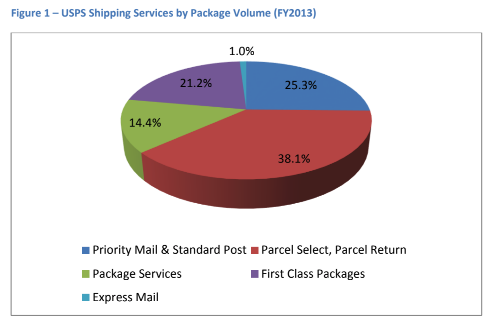
For its most recent earnings report, package volume for Parcel Select & Parcel Return was up 8.3% over 2012, and revenue increased a whopping 19.4%.
FedEx SmartPost has been the fastest growing service segment within FedEx in recent years, doubling and even tripling YOY volume growth over its Ground unit (Figure 2.)
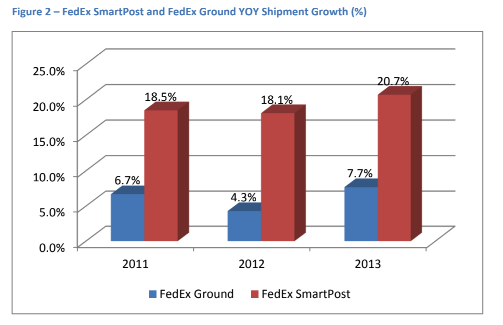
SmartPost has achieved an aggregate volume increase of 233% since FY2008. (Figure 3.)
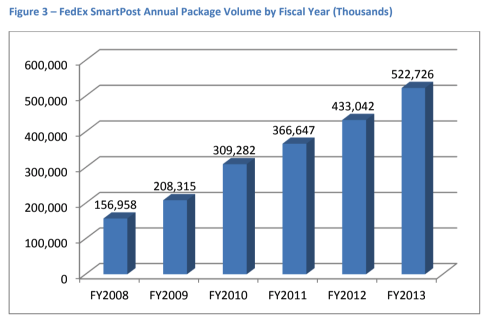
At nearly 533 million packages delivered in 2013, SmartPost volume was just under half of FedEx Ground’s FY2013 package volume of just over 1 billion packages.
Revenue growth at SmartPost has been equally impressive. Nearly $1 billion in revenue in FY2013, SmartPost achieved 92.5% revenue growth since 2010. (Figure 4.)
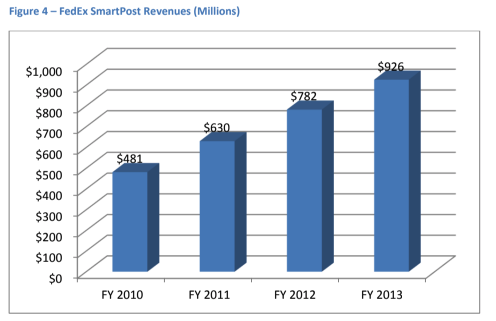
Note, as UPS financial statements combine multiple service categories, we are not able to report on specific SurePost growth. However, the UPS annual report for 2012 includes several instances in which the company discusses the rapid growth of the product.
An interesting side note regarding UPS SurePost is the significance the product played during recent UPS/Teamsters contract talks. Since UPS SurePost packages are aggregated and inducted for USPS postal carrier delivery, Teamster negotiators view SurePost with extreme caution since it could have a negative impact on union labor. Simply put, it takes packages away from Union drivers and puts those packages in the hands of USPS postal carriers.
As a result, the final master labor contract places several important restrictions on UPS SurePost as Follows:
- Surepost will not be presented as a general service offering, but rather it will be offered to existing commercial customers that ship from a business to a residential customer, and only when solicited by a competitor offering services similar to SurePost and/or to attract new commercial customers. UPS agrees to discontinue the product in the event its competitors did so as well.
- Packages eligible for such delivery will normally be less than ten pounds in weight and less than three cubic feet in size. Within 120 days of the effective date of the new contract, the Company shall also develop technology that identifies oversized (greater than three cubic feet) or overweight packages. Once such technology is operational, all Surepost packages exceeding ten pounds or with dimensions greater than three cubic feet, will be delivered by UPS package drivers.
- UPS must continue to use and develop technology that identifies two or more Surepost packages to be delivered to the same address and/or any combination of Surepost package/s and ground package/s to be delivered to the same address. In such circumstances, all of the Surepost package/s and ground package/s will be delivered by UPS package drivers. In addition, UPS will develop and implement technology that identifies multiple addresses in close proximity to which any combination of Surepost and ground packages are to be delivered.
- A Joint UPS/Teamsters Competition Committee will meet on a quarterly basis to review the progress of the SurePost progress and discuss potential technological enhancements that will allow Surepost volume to be placed back in the UPS system for final mile delivery.
- Finally, in the event of a dispute, should an arbitrator determine that UPS expanded SurePost beyond the scope of the new contract without first obtaining the consent of the Union, the arbitrator has the authority to fashion a remedy based on the nature and extent of the violation, including issuing a cease and desist order that requires UPS to terminate the expanded service.
Are All Parcel Expeditors the Same?
If the USPS is making all the final mile deliveries, are all these services essentially the same?
Categorically, they are not the same. Infrastructures vary greatly, which of course impacts how quickly and where your parcel is entered into the USPS delivery stream. Some companies consolidate packages and won’t send a truck to larger sorting facilities or USPS entry points until the truck is mostly or entirely full, leading to additional delays.
While FedEx SmartPost utilizes a network of 25 SmartPost hubs that distribute scheduled loads into all three types of USPS entry points (Figure 5), UPS SurePost packages are transported via the UPS Ground network and are always inducted at the DDU, the closest postal facility to the consignee’s place of residence.
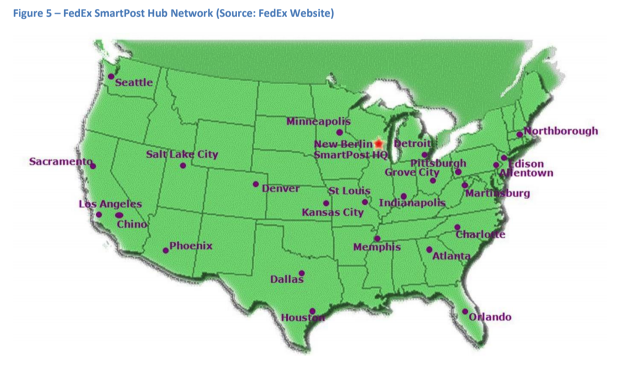
What About Pricing?
Rates can vary, too. Packages inducted at the DDU receive the best pricing from the USPS. However, it costs the parcel aggregator more to deliver to the DDU than further upstream in the USPS network.
FedEx SmartPost and UPS SurePost published rates are similar, but not exact. Each matches its published Ground pricing up to 9 pounds for the contiguous U.S. (Zones 2-8). FedEx SmartPost rates are provided in Figure 6.
It’s important that shippers understand that at 10 pounds and higher, FedEx SmartPost rates are actually 36% higher than FedEx Ground and FedEx Home Delivery services.
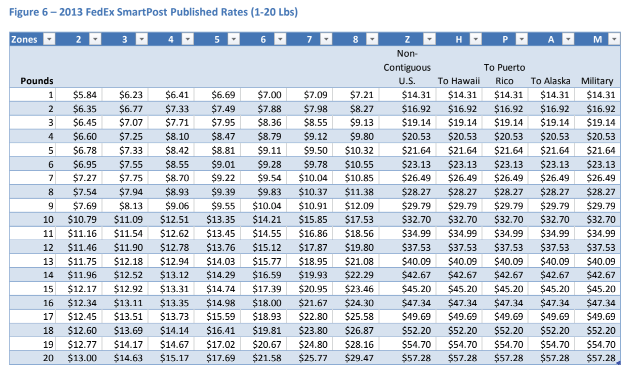
UPS SurePost’s published pricing matches FedEx SmartPost up to 9 pounds – a mirror of its Ground pricing – within the contiguous U.S. However, pricing above 9 pounds and non-contiguous U.S. is significantly higher with UPS SurePost than FedEx SmartPost. (Figure 7.)
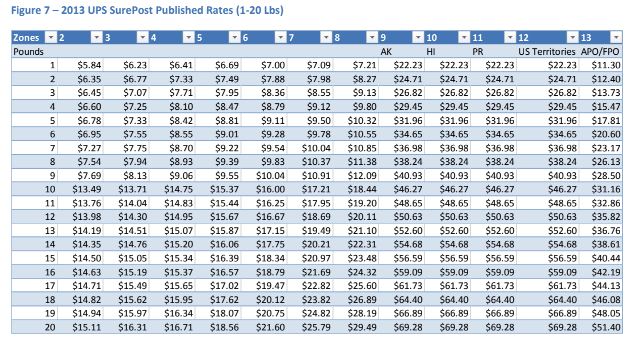
Rather than applying a fixed increase above 10 pounds (like SmartPost’s flat 36% increase), UPS increases SurePost rates by $5.55 (or more) over Ground published pricing. (Figure 8.)
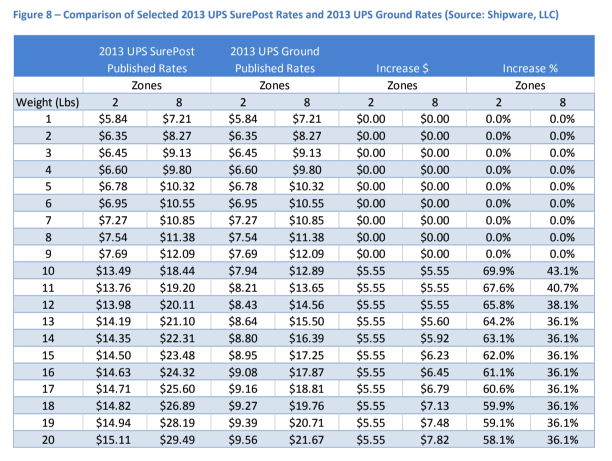
What About Discounts?
Volume shippers should work with their carrier reps to negotiate discounts off published rates. What incentive should you receive? Of course, carrier pricing depends on many factors including package characteristics, pickup and destination delivery density, proximity of your DC’s to processing facilities, parcel volumes, competition, sales commissions, cost to service your account, and many other items. That said, it’s not unusual to hear of high-volume shippers that have negotiated SmartPost incentives well into the 70’s.
Other negotiable items include surcharges (fuel, DAS, non-machinable charges, and others) as well as reductions to minimum charges. Shippers should measure the impact of the minimum charges as it is often an important point for negotiation. Volume shippers should be able to negotiate a minimum reduction at least $3.00 off minimum charges (2013 minimum charge is $5.84) for packages under 1 pound (resulting in a minimum charge of $2.84), and at least $2.00 minimum reduction for packages at 1 pound and above (resulting in a $3.84 minimum charge).
My personal experience is that FedEx SmartPost offers higher discounts than UPS SurePost. However, UPS representatives have made the argument that SurePost rates are higher because it’s a better product than FedEx SmartPost. They advise shippers to consider that SurePost parcels are distributed through the UPS Ground network, and moreover, are always inducted at the DDU – the final postal facility closest to the recipient. Therefore, transits are more predictable and consistent.
However, any pricing advantage FedEx SmartPost has enjoyed might be changing. Several shippers have recently reported receiving very competitive SurePost pricing proposals, better than ever before.
It is also important that shippers understand the various product categories and negotiate pricing for various mail classes like Parcel Select, Parcel Select Lightweight (packages < 16 ounces), Bound Printed Matter, and Media Mail as needed.
Of course, USPS costs factor into pricing offered by parcel expeditors since the USPS handles the final mile delivery. Although USPS rates can vary contract to contract amongst parcel expeditors, shippers can download published Parcel Select pricing tables at:
https://www.usps.com/business/parcel-select.htm. A simple comparison of USPS pricing tables and proposed pricing from parcel aggregators will give you a better sense of the service providers fixed costs and margin at the shipment level.
UPS SurePost vs. UPS Mail Innovations
Several shippers have told me they are confused by similar product offerings within UPS – specifically, UPS Mail Innovations (UPS-MI) versus UPS SurePost.
UPS-MI is operated through UPS’s Supply Chain & Freight segment. UPS-MI offers distinct services than UPS SurePost – which operates under UPS’s global small package operations – with UPS-MI specializing in the handling of global mail products including flats, BPM, Media Mail and parcels under 1 pound. On the other hand, UPS SurePost principally handles parcel select products under/over 1 pound.
There are multiple operational distinctions as well. UPS-MI uses 17 separate regional processing facilities networked around USPS entry points, whereas SurePost is transported through the UPS Ground network. SurePost uses a UPS tracking label that includes USPS Delivery Confirmation, while UPS-MI uses a USPS tracking number. SurePost is always inducted at the DDU, whereas UPS-MI inducts at a combination of BMC’s, SCF’s and DDU’s.
Other Providers
To this point, I’ve talked a lot about FedEx SmartPost and UPS SurePost – the “big two”. However, the USPS has multiple Parcel Select partners. Figure 10 provides a partial list of domestic parcel providers under partnership with the USPS for Parcel Select and other products. (Figure 9.)

To obtain the best pricing and service, shippers should invest time in evaluating proposals for each of the major parcel expeditors.
Enabling Technologies
Regardless of which national parcel expeditor you chose, your sales representative should be able to provide a list of automation vendors that support its services. A partial list includes Best Ways Technologies, ConnectShip, Fascor, HAL Systems, Harvey Software, Kewill, Logicor, LRM Technologies, Malvern, Manhattan Associates, PathGuide Technologies, Pitney Bowes, Varsity Logistics, V-Technologies and others.
Parcel Select to Lower Shopping Cart Abandonment
Shipping costs are the number one reason for shopping cart abandonment. When presented with a choice, many online shoppers will choose the free (or low cost) delivery option even if it means a potentially longer transit. This may enhance customer loyalty, increase repeat orders while driving revenue and increase profitability. Outdoor apparel and textiles manufacturer Woolrich significantly reduced its overall shipping costs by shifting the majority of its Ground residential shipments to deferred ground services using UPS SurePost. Conrad Schlesinger, Woolrich’s distribution manager, says almost 90% of its orders shifted from UPS Ground Residential to UPS SurePost, and the only change Woolrich made was adding a lower cost, deferred ground alternative to its website.
Summary
In summary, Parcel Select service options are expanding and can represent a valuable opportunity for shippers, USPS and partners alike. While all parcel expeditors are not the same, shippers should carefully evaluate the various services, transit and pricing options available, and negotiate meaningful discounts that include freight incentives and concessions on accessorial charges as well as minimum charges.